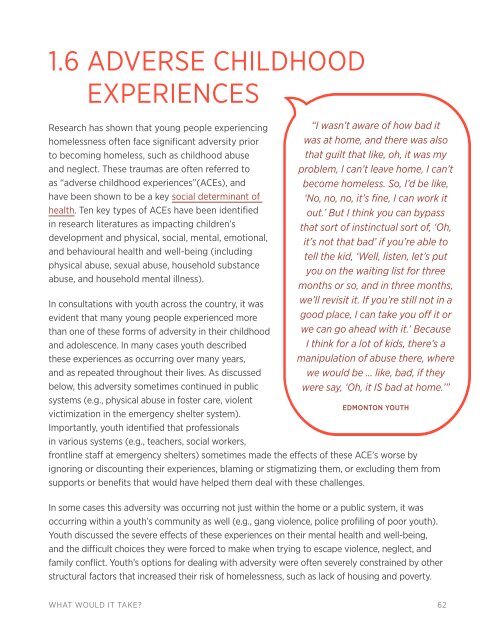COH-AWH-What_Would_it_Take
Create successful ePaper yourself
Turn your PDF publications into a flip-book with our unique Google optimized e-Paper software.
1.6 ADVERSE CHILDHOOD<br />
EXPERIENCES<br />
Research has shown that young people experiencing<br />
homelessness often face significant advers<strong>it</strong>y prior<br />
to becoming homeless, such as childhood abuse<br />
and neglect. These traumas are often referred to<br />
as “adverse childhood experiences”(ACEs), and<br />
have been shown to be a key social determinant of<br />
health. Ten key types of ACEs have been identified<br />
in research l<strong>it</strong>eratures as impacting children’s<br />
development and physical, social, mental, emotional,<br />
and behavioural health and well-being (including<br />
physical abuse, sexual abuse, household substance<br />
abuse, and household mental illness).<br />
In consultations w<strong>it</strong>h youth across the country, <strong>it</strong> was<br />
evident that many young people experienced more<br />
than one of these forms of advers<strong>it</strong>y in their childhood<br />
and adolescence. In many cases youth described<br />
these experiences as occurring over many years,<br />
and as repeated throughout their lives. As discussed<br />
below, this advers<strong>it</strong>y sometimes continued in public<br />
systems (e.g., physical abuse in foster care, violent<br />
victimization in the emergency shelter system).<br />
Importantly, youth identified that professionals<br />
in various systems (e.g., teachers, social workers,<br />
“I wasn’t aware of how bad <strong>it</strong><br />
was at home, and there was also<br />
that guilt that like, oh, <strong>it</strong> was my<br />
problem, I can’t leave home, I can’t<br />
become homeless. So, I’d be like,<br />
‘No, no, no, <strong>it</strong>’s fine, I can work <strong>it</strong><br />
out.’ But I think you can bypass<br />
that sort of instinctual sort of, ‘Oh,<br />
<strong>it</strong>’s not that bad’ if you’re able to<br />
tell the kid, ‘Well, listen, let’s put<br />
you on the wa<strong>it</strong>ing list for three<br />
months or so, and in three months,<br />
we’ll revis<strong>it</strong> <strong>it</strong>. If you’re still not in a<br />
good place, I can take you off <strong>it</strong> or<br />
we can go ahead w<strong>it</strong>h <strong>it</strong>.’ Because<br />
I think for a lot of kids, there’s a<br />
manipulation of abuse there, where<br />
we would be … like, bad, if they<br />
were say, ‘Oh, <strong>it</strong> IS bad at home.’”<br />
EDMONTON YOUTH<br />
frontline staff at emergency shelters) sometimes made the effects of these ACE’s worse by<br />
ignoring or discounting their experiences, blaming or stigmatizing them, or excluding them from<br />
supports or benef<strong>it</strong>s that would have helped them deal w<strong>it</strong>h these challenges.<br />
In some cases this advers<strong>it</strong>y was occurring not just w<strong>it</strong>hin the home or a public system, <strong>it</strong> was<br />
occurring w<strong>it</strong>hin a youth’s commun<strong>it</strong>y as well (e.g., gang violence, police profiling of poor youth).<br />
Youth discussed the severe effects of these experiences on their mental health and well-being,<br />
and the difficult choices they were forced to make when trying to escape violence, neglect, and<br />
family conflict. Youth’s options for dealing w<strong>it</strong>h advers<strong>it</strong>y were often severely constrained by other<br />
structural factors that increased their risk of homelessness, such as lack of housing and poverty.<br />
WHAT WOULD IT TAKE? 62
















